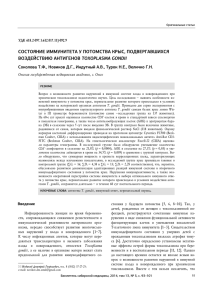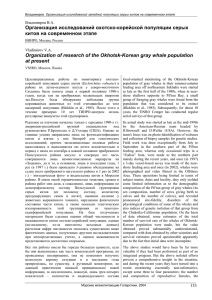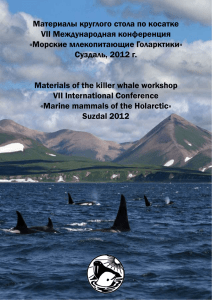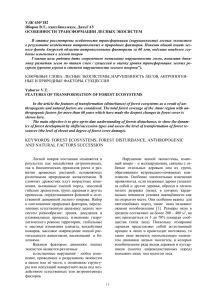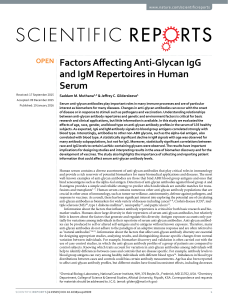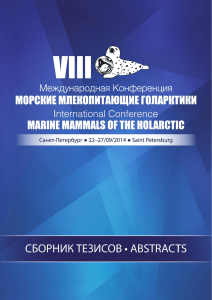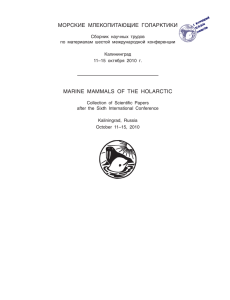Serological Detection of Causative Agents of Infectious and Invasive Diseases in the Beluga Whale Delphinapterus leucas (Pallas, 1776) (Cetacea Monodontidae) from Sakhalinsky Bay
реклама
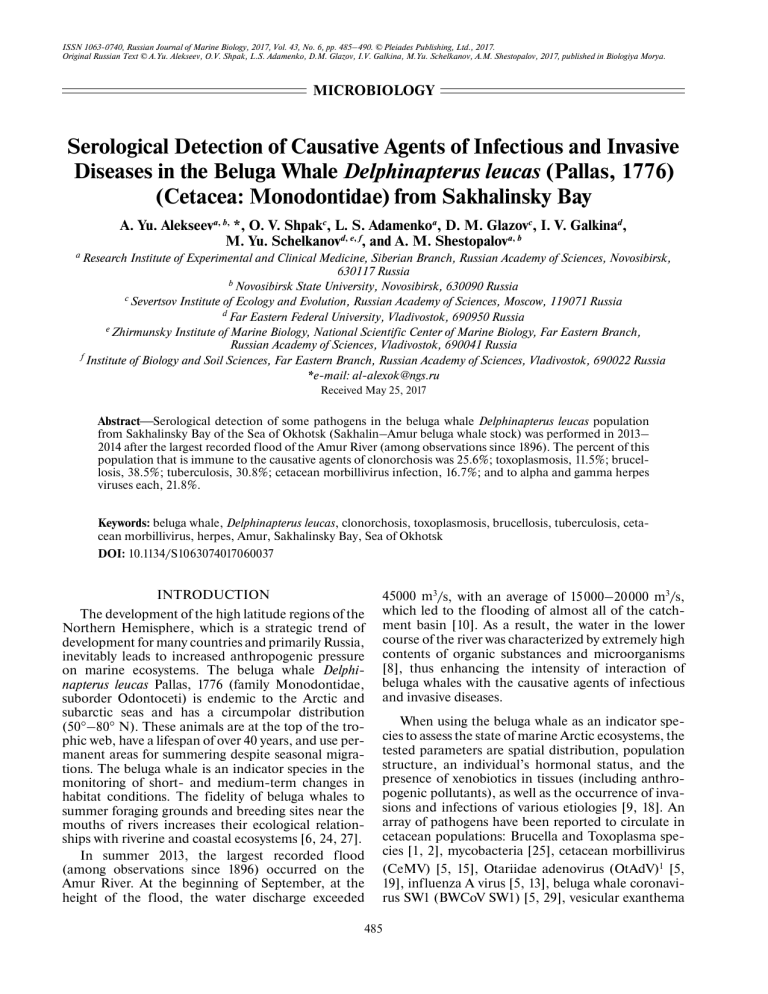
ISSN 1063-0740, Russian Journal of Marine Biology, 2017, Vol. 43, No. 6, pp. 485–490. © Pleiades Publishing, Ltd., 2017. Original Russian Text © A.Yu. Alekseev, O.V. Shpak, L.S. Adamenko, D.M. Glazov, I.V. Galkina, M.Yu. Schelkanov, A.M. Shestopalov, 2017, published in Biologiya Morya. MICROBIOLOGY Serological Detection of Causative Agents of Infectious and Invasive Diseases in the Beluga Whale Delphinapterus leucas (Pallas, 1776) (Cetacea: Monodontidae) from Sakhalinsky Bay A. Yu. Alekseeva, b, *, O. V. Shpakc, L. S. Adamenkoa, D. M. Glazovc, I. V. Galkinad, M. Yu. Schelkanovd, e, f, and A. M. Shestopalova, b a Research Institute of Experimental and Clinical Medicine, Siberian Branch, Russian Academy of Sciences, Novosibirsk, 630117 Russia b Novosibirsk State University, Novosibirsk, 630090 Russia c Severtsov Institute of Ecology and Evolution, Russian Academy of Sciences, Moscow, 119071 Russia d Far Eastern Federal University, Vladivostok, 690950 Russia e Zhirmunsky Institute of Marine Biology, National Scientific Center of Marine Biology, Far Eastern Branch, Russian Academy of Sciences, Vladivostok, 690041 Russia f Institute of Biology and Soil Sciences, Far Eastern Branch, Russian Academy of Sciences, Vladivostok, 690022 Russia *e-mail: [email protected] Received May 25, 2017 Abstract⎯Serological detection of some pathogens in the beluga whale Delphinapterus leucas population from Sakhalinsky Bay of the Sea of Okhotsk (Sakhalin–Amur beluga whale stock) was performed in 2013– 2014 after the largest recorded flood of the Amur River (among observations since 1896). The percent of this population that is immune to the causative agents of clonorchosis was 25.6%; toxoplasmosis, 11.5%; brucellosis, 38.5%; tuberculosis, 30.8%; cetacean morbillivirus infection, 16.7%; and to alpha and gamma herpes viruses each, 21.8%. Keywords: beluga whale, Delphinapterus leucas, clonorchosis, toxoplasmosis, brucellosis, tuberculosis, cetacean morbillivirus, herpes, Amur, Sakhalinsky Bay, Sea of Okhotsk DOI: 10.1134/S1063074017060037 INTRODUCTION The development of the high latitude regions of the Northern Hemisphere, which is a strategic trend of development for many countries and primarily Russia, inevitably leads to increased anthropogenic pressure on marine ecosystems. The beluga whale Delphinapterus leucas Pallas, 1776 (family Monodontidae, suborder Odontoceti) is endemic to the Arctic and subarctic seas and has a circumpolar distribution (50°–80° N). These animals are at the top of the trophic web, have a lifespan of over 40 years, and use permanent areas for summering despite seasonal migrations. The beluga whale is an indicator species in the monitoring of short- and medium-term changes in habitat conditions. The fidelity of beluga whales to summer foraging grounds and breeding sites near the mouths of rivers increases their ecological relationships with riverine and coastal ecosystems [6, 24, 27]. In summer 2013, the largest recorded flood (among observations since 1896) occurred on the Amur River. At the beginning of September, at the height of the flood, the water discharge exceeded 45000 m3/s, with an average of 15000–20000 m3/s, which led to the flooding of almost all of the catchment basin [10]. As a result, the water in the lower course of the river was characterized by extremely high contents of organic substances and microorganisms [8], thus enhancing the intensity of interaction of beluga whales with the causative agents of infectious and invasive diseases. When using the beluga whale as an indicator species to assess the state of marine Arctic ecosystems, the tested parameters are spatial distribution, population structure, an individual’s hormonal status, and the presence of xenobiotics in tissues (including anthropogenic pollutants), as well as the occurrence of invasions and infections of various etiologies [9, 18]. An array of pathogens have been reported to circulate in cetacean populations: Brucella and Toxoplasma species [1, 2], mycobacteria [25], cetacean morbillivirus (CeMV) [5, 15], Otariidae adenovirus (OtAdV)1 [5, 19], influenza A virus [5, 13], beluga whale coronavirus SW1 (BWCoV SW1) [5, 29], vesicular exanthema 485 486 ALEKSEEV et al. of swine virus (VESV)2 [5, 26], beluga whale herpes virus (BWHV) [14], Phocoena spinipinnis papillomavirus (PsPV) [5], and cetacean poxvirus 1 (CPV-1) [5, 16]. The aim of the present research was to perform serological detection of several pathogens in the beluga whale population that summers in Sakhalinsky Bay of the Sea of Okhotsk (Sakhalin–Amur beluga whale stock), based on materials collected in 2013– 2014 during and after a catastrophic flood of the Amur River (2013) and to compare the results with the data for the same beluga whale population in 2002–2007 and 2007–2009 [1, 2]. MATERIALS AND METHODS Beluga whales at ages of 2–10+ (with colors ranging from gray to white) were caught in Sakhalinsky Bay off Baidukov and Chkalov islands. Samples of peripheral blood of beluga whales were taken in July–September 2013 (39 ind.) and in June–September 2014 (39 ind.). Blood from thin-walled veins of the caudal fin was collected into Vacutainer vacuum tubes. Serum was allowed to separate or the blood samples were centrifuged at 3000–3200 rpm for 15 min. After separation, the plasma or serum was placed in polyethylene tubes and frozen at –18°C. Samples were transported to the laboratory in a foamed plastic container with cooling agents (the temperature at opening did not exceed 8°C). Prior to the experiment, serum samples were stored in the laboratory at –24°C. The serum was completely thawed at room temperature and diluted to a working dilution (1 : 20) with phosphate saline buffer (pH 7.4). The samples were then tested using a solid phase enzyme-linked immunoassay (ELISA) in four dilutions (1 : 20, 1 : 40, 1 : 80, and 1 : 160; each in four replicates) on the same 96-welled immunological plate. The principle of the method consists of the interaction of the antibodies to the causative agents of disease that are present in the analyzed sample with the respective antigen immobilized on the surface of wells of the plate. The “antigen–antibody” complex was detected using a horseradish peroxidase conjugate with the Toxoplasma gondii antigen or with Staphylococcus aureus recombinant protein A. The antigen–antibody–conjugate was revealed by a color reaction using peroxidase substrate and chromogen. The chromogen in all test systems was tetramethyl benzidine (TMB). The staining intensity was proportional to the concentration of specific antibodies in the analyzed samples. The duration of the analysis varied from 100 to 140 min in accordance with the test-system manual; 100 μL of the diluted serum was placed in 1 The virus name refers to the fact that the prototype strain was isolated from the liver of stranded Calofornia sea lions (Zalophus californianus) (Carnivora: Otariidae) [22]; however, the virus can also infect beluga whales. 2 VESV currently includes several previously considered distinct viruses: cetacean calicivirus (CtCV), San Miguel sea lion virus (SMSV), and walrus calicivirus (WCV). a well.1 The sample was considered positive if all 1 : 40 dilution replicates were found positive; the mean values of successive dilutions formed a monotonous decreasing succession. Identification of T. gondii antibodies was performed using a VektoTokso-antitela ELISA test system (Vektor-Best, Russia), followed by detection of immune complexes (ICs) with a horseradish peroxidase–T. gondii antigen conjugate according to the manufacturer’s protocol; Mycobacterium tuberculosis antibodies, AT-TubBest ELISA test system (VektorBest, Russia) and recombinant protein A–horseradish peroxidase (RPA–HRP) conjugate (Bialeksa, Russia) for ICs detection; antibodies to the most common Brucella species (B. melitensis, B. abortus, and B. suis), Brutsella-IgG-IFA-Best ELISA test system (VektorBest, Russia) and RPA–HRP conjugate; antibodies to the trematode Clonorchis sinensis, Klonorkhis-IgGIFA-Best ELISA test system (Vektor-Best, Russia) and RPA–HRP conjugate. The humoral immunity against morbilliviruses was detected by ELISA using the canine distemper virus (CDV) antigen [5] in the composition of a Vladivak-Ch commercial vaccine (Bionit, Russia); ICs were revealed with the RPA– HRP conjugate. Antibodies to herpes viruses were identified using two ELISA test systems: Vekto-VZV-IgG (VektorBest, Russia) containing antigens to human herpesvirus 3 (HHV-3) and Vekto-VEB-VCA-IgG-avidnost (Vektor-Best, Russia) containing a recombinant capsid antigen of the Epstein–Barr virus (human herpesvirus 4, HHV-4) [5]; ICs were revealed with the RPA– HRP conjugate. RESULTS The proportion of beluga whales that were serologically positive to Clonorchis sinensis was 43.6% in 2013, 7.7% in 2014, and 25.6% for the entire observation period (2013–2014). Antibodies to Toxoplasma gondii were found in 12.8, 10.3, and 11.5% of the animals, respectively; to Brucella species (Brucella melitensis, B. abortus, and B. suis), 61.5, 15.4, and 38.5% of individuals; to the Mycobacterium tuberculosis complex, 28.2, 33.3, and 30.8%; to morbilliviruses antigens, 15.4, 17.9, and 16.7%; to HHV-3, 23.1, 20.5, and 21.8%; to HHV-4, 20.5, 23.1, and 21.8% of individuals. The presence of antibodies to only one of the investigated pathogens was detected in 12 beluga whales (31.6%) in 2013 and in 3 beluga whales (7.9%) in 2014 (Table 1). The concurrent presence in the blood of antibodies to two–five pathogens was serologically confirmed in 24 animals (61.5%) in 2013 and in 17 (43.6%) in 2014. Among beluga whales with cooccurrence of antibodies to several pathogens, more common in 2013 were those with antibodies to the Brucella complex (17 cases), to the trematode C. sinensis (15 cases), and to the Mycobacterium tuberculosis complex (10 cases). In 2014, beluga whales with anti- RUSSIAN JOURNAL OF MARINE BIOLOGY Vol. 43 No. 6 2017 RUSSIAN JOURNAL OF MARINE BIOLOGY Vol. 43 No. 6 2017 “+,” Serologically positive result; “–,” serologically negative result. Table 1. Results of the detection of antibodies to the causative agents of infectious and invasive diseases in beluga whales from Sakhalinsky Bay of the Sea of Okhotsk (2013–2014) Number of individual; the value in parentheses The presence of antibodies to Number is the percent of the total number of pathogens Clonorchis Toxoplasma Mycobacterium Brucella Morbillivirus Varicellovirus Lymphocryptovirus 2013 2014 2013–2014 0 – – – – – – – 3 (7.7) 19 (48.7) 22 (28.2) 1 + – – – – – – 2 (5.1) 0 (0.0) 2 (2.6) – + – – – – – 0 (0.0) 0 (0.0) 0 (0.0) – – + – – – – 1 (2.6) 0 (0.0) 1 (1.3) – – – + – – – 7 (17.9) 0 (0.0) 7 (9.0) – – – – + – – 0 (0.0) 1 (2.6) 1 (1.3) – – – – – + – 0 (0.0) 1 (2.6) 1 (1.3) – – – – – – + 2 (5.1) 1 (2.6) 3 (3.8) 2 + + – – – – – 1 (2.6) 0 (0.0) 1 (1.3) + – – + – – – 2 (5.1) 0 (0.0) 2 (2.6) – + – + – – – 1 (2.6) 0 (0.0) 1 (1.3) – + – – + – – 0 (0.0) 1 (2.6) 1 (1.3) – + – – – + – 0 (0.0) 1 (2.6) 1 (1.3) – – + + – – – 2 (5.1) 3 (7.7) 5 (6.4) – – + – + – – 2 (5.1) 0 (0.0) 2 (2.6) – – + – – + – 0 (0.0) 2 (5.1) 2 (2.6) – – – + – + – 1 (2.6) 0 (0.0) 1 (1.3) – – – – – + + 0 (0.0) 2 (5.1) 2 (2.6) 3 + – + + – – – 0 (0.0) 1 (2.6) 1 (1.3) + – + – – + – 2 (5.1) 0 (0.0) 2 (2.6) + – – + + – – 1 (2.6) 0 (0.0) 1 (1.3) + – – + – + – 1 (2.6) 0 (0.0) 1 (1.3) + – – + – – + 2 (5.1) 0 (0.0) 2 (2.6) + – – – – + + 1 (2.6) 0 (0.0) 1 (1.3) – + – + – – + 1 (2.6) 0 (0.0) 1 (1.3) – – – + + + – 1 (2.6) 0 (0.0) 1 (1.3) – – + – – + + 1 (2.6) 1 (2.6) 2 (2.6) – + + – + – – 0 (0.0) 1 (2.6) 1 (1.3) – – + – + – + 0 (0.0) 1 (2.6) 1 (1.3) 4 + + + + – – – 1 (2.6) 0 (0.0) 1 (1.3) + + – + – – + 1 (2.6) 0 (0.0) 1 (1.3) + – + + + – – 1 (2.6) 0 (0.0) 1 (1.3) + – + + – + – 1 (2.6) 0 (0.0) 1 (1.3) + – + + – – + 0 (0.0) 1 (2.6) 1 (1.3) + – – + + + – 1 (2.6) 0 (0.0) 1 (1.3) – + + – + – + 0 (0.0) 1 (2.6) 1 (1.3) – – + – + + + 0 (0.0) 1 (2.6) 1 (1.3) 5 + – + + + – + 0 (0.0) 1 (2.6) 1 (1.3) SEROLOGICAL DETECTION OF CAUSATIVE AGENTS OF INFECTIOUS 487 488 ALEKSEEV et al. bodies to the M. tuberculosis complex (13 cases) and the gamma herpesvirus Lymphocryptovirus (8 cases) were found most frequently. The proportion of serum samples that were seronegative for the investigated pathogens was 7.7% in 2013 (3 serum samples) and 48.7% in 2014 (19 serum samples). DISCUSSION The parasitic protist Toxoplasma gondii, a member of a monotypic genus that is widespread among mammals, birds, and reptiles. Its definitive host is the cat family (Felidae), in which all the life-cycle stages of the parasite take place. Cats begin to disseminate T. gondii oocysts after ingesting any of its infectious stages. Having been excreted in feces, the toxoplasma oocysts remain viable in the environment for more than 1 year. The beluga whale can be infected with T. gondii by several routes: alimentary (via water), percutaneous (as a result of skin injuries from contacts with seal claws and body scrub while molting and in search for food in the shallows), and transplacental (from mother to fetus). The proportion of individuals that were seropositive for T. gondii increased in 2013– 2014 by a factor of 2.5 compared to 2002–2007 (4.8%) and by a factor of 1.5 compared to 2007–2009 (7.7%) [1, 2]. This may be connected with the increased human population on the Chinese coast of the Amur River accompanied by the growth in number of domestic animals. The 2013 catastrophic flood in the Amur River basin led to the massive washing of cat feces and dead animals, which carry T. gondii tissue cysts, into the river and then into Sakhalinsky Bay of the Sea of Okhotsk. In beluga whales, like other mammals, the immunity to Toxoplasma probably is retained for life. A 19.5% decrease in the proportion of immune beluga whales in 2014, compared to 2013, can be explained by that T. gondii is able to alter the behavior of the infected individuals [20]. It is known that when T. gondii infects mice and rats (Muridae), the rodents acquire an interest in investigating new territories and become more daring and less afraid of cats (their natural predator). In humans, excess dopamine, which is caused by the activities of the pathogen, leads to a higher ability to take risks, slower reactions, the feeling of unsafety, anxiousness, neurotism, and psychoses, whose manifestations do not virtually differ from the symptoms of schizophrenia [23]. Behavioral alteration in beluga whales could be fatal in the winter, when the animals must follow the location of polynyas and remain at the ice edge [6, 12, 24]. Clonorchis sinensis is widespread in the Amur River basin [11]. The first intermediate host of this helminth is freshwater gastropods of the genus Bithynia; the second is various species of fish, mainly freshwater cyprinid fishes. Metacercariae that are contained in them cause the infection of the final host while eating contaminated fish. Many species of mammals, among them beluga whale, as shown by our investigations, become the final hosts of C. sinensis. In areas where large rivers flow into the sea, beluga whales feed on mollusks and fish, including freshwater species. The flood in 2013 and, as a consequence, the freshening of the Amur Estuary evidently led to the increase in the population of freshwater mollusks and river fish in the Amur River mouth, causing a peak of infection in beluga whales (43.6%). However, it is known that the immunity after this disease is not long lasting and not persistent [4]; therefore, in 2014 the proportion of C. sinensis-infected beluga whales had already decreased to 7.7%.3 The current taxonomy of the genus Brucella includes several species that are associated with certain hosts: В. bovis, including the typical species В. abortus (the hosts are the Bos genus); В. canis (dogs); В. neatomae (bush rats); В. ovis, including the typical species В. melitensis (rams); and В. suis (wild boars). At the same time, Brucella species can infect nonspecific hosts. Thus, diseases in humans are most often associated with B. melitensis, B. abortus, and B. suis, which allows inclusion of these Brucella species into commercial test systems in medicine. Brucella species that are specific to marine mammals have not been described thus far. The most likely path of infection of beluga whales is via the fecal–oral route, in which the feces of terrestrial mammals dissolved in fresh water are transferred to the estuarine areas. According to earlier data, the average annual level of Brucella-seropositive beluga whales in Sakhalinsky Bay was 13.6% in 2002–2007 and 13.2% in 2007–2009 [1, 2]. As a result of the 2013 flood, the agricultural lands in the Amur River basin were flooded, consequently leading to an outbreak of Brucella infection in beluga whales; the proportion of immune individuals increased to 61.5%. Since, in the case of brucellosis, the humoral postinfection immunity is not persistent [7], the proportion of seropositive individuals had already decreased to 15.4% in 2014. Mycobacterium tuberculosis is the type of a group of related species of the genus Mycobacterium. Each of them most effectively infects its main hosts: M. tuberculosis and M. africanum, primates; M. bovis and M. caprae, large and small cattle; M. microti, rodents; M. pinnipedii, true seals. However, these bacteria can also infect other taxonomic groups of mammals. The antigens of M. tuberculosis cause the production of specific antibodies with a high level of immune crossreactivity within the genus Mycobacterium. Of the M. tuberculosis complex, the most likely agent that infects beluga whales is M. pinnipedii, which was first described in 2003 [17]. Infection occurs via airborne droplets as a result of contacts between beluga whales and seals in the shallows. The presence of antibodies to the Mycobacterium tuberculosis complex has 3 Detection of antibodies against C. sinensis was not carried out in previous publications [1, 2]. RUSSIAN JOURNAL OF MARINE BIOLOGY Vol. 43 No. 6 2017 SEROLOGICAL DETECTION OF CAUSATIVE AGENTS OF INFECTIOUS been shown in three out of ten beluga whales (33%) caught in 2010 off Chkalov Island [3]. The data obtained in 2013–2014 indicated that 30.8% of beluga whales were seropositive to the M. tuberculosis complex; however, this cannot be compared and interpreted as a tendency because of the small number of the investigated individuals. It can be supposed that the 2013 flood did not have any substantial influence on the prevalence of mycobacteria in beluga whales. At the beginning of 21th century, studies using molecular-genetic methods showed that the carnivore distemper virus, which was previously considered to be a pathogen of all predatory animals, consists of several separate viruses that are specific to individual taxonomic groups [21]. These are canine distemper virus (CDV) specific to dogs, cetacean morbillivirus (CeMV) to cetaceans, and phocine distemper virus (PDV) to pinnipeds. The use of CDV antigens instead of CeMV antigens is correct due to the extremely high immunological cross-reactivity between the Morbillivirus species [5, 28]. Comparison of results of the present study with published data [1, 2] showed that the flood of the Amur River did not influence the level of the CeMV infection. Our investigations confirmed the circulation of herpes viruses in beluga whales of the Sakhalin–Amur stock; however, the results are not detailed because the viruses must be isolated and characterized. The presence of antibodies against pinniped herpes viruses cannot be excluded. The data on the simultaneous occurrence of antibodies against several pathogens in the blood of beluga whales (see Table 1) suggest that the investigated agents cause chronic diseases and a general decline of immunity, leading to attacks by other pathogens. This is supported by the fact that a significant part (52.3%) of all investigated animals experienced coinfection. In 2014, compared to 2013, the proportion of individuals that were seronegative to all pathogens increased by a factor of more than 6 (see Table 1). It appears that under sharp changes of ecological conditions (e.g., the extreme flood of the Amur River) uninfected and uninvaded individuals have a substantial selective advantage. It should be noted that, apart from the September flood, another characteristic feature of 2013 was an unusually late clearance of ice (our own observations). This negatively affected the time and intensity of entry by fish and, consequently, the health of mammals. These factors were likely to cause the increased proportion of pathogenseropositive beluga whales in Sakhalinsky Bay (the Sea of Okhotsk) in 2013. Our study has shown that extreme discharges of the Amur River during floods significantly affect the prevalence of infection of beluga whales with infectious and invasive diseases, primarily toxoplasmosis, chlonorchosis, and tuberculosis, whose causative agents are associated with terrestrial animals. RUSSIAN JOURNAL OF MARINE BIOLOGY Vol. 43 489 ACKNOWLEDGMENTS The collection and analysis of materials was financed by the Ocean Park Corporation (Hongkong). This study was performed within the framework of the State’s Task to the Research Institute of Experimental and Clinical Medicine, project no. 0535-2014-0008 and the project New Institutions of Global and Regional Governance in Eurasia and Asia-Pacific Region of Far Eastern Federal University. The authors are grateful to M.A. Solovyeva (Moscow State University, Moscow), A.Yu. Paramonov (Marine Mammal Council, Moscow), and M.N. Ososkova (Fauna Veterinary Clinics, Moscow) for collaboration in sampling the material. REFERENCES 1. Alekseev, A.Yu., Reguzova, A.Yu., Rozanova E.I., et al., Detection of specific antibodies to morbilliviruses, Brucella and Toxoplasma in the Black Sea dolphin Tursiops truncatus ponticus and the beluga whale Delphinapterus leucas from the Sea of Okhotsk in 2002– 2007, Russ. J. Mar. Biol., 2009, vol. 35, no. 6, pp. 494– 497. 2. Alekseev, A.Yu., Sivai, M.V., Russkova, O.V., et al., Revealing of specific antibodies to morbilliviruses, Brucella and Toxoplasma in the beluga whale Delphinapterus leucas from the Sea of Okhotsk in 2007–2009, Materialy 6-i mezhdunarodnoi konferentsii “Morskie mlekopitayushchie Golarktiki,” Kaliningrad, Rossiya, 11–15 oktyabrya 2010 g. (Proc. 6th Int. Conf. “Marine Mammals of the Holarctic,” Kaliningrad, Russia, October 11–15, 2010), Kaliningrad: Kapros, 2010, pp. 27–29. 3. Alekseev, A.Yu., Sivai, M.V., Saifutdinova, S.G., et al., Monitoring of Some Pathogens in marine mammals and birds at Chkalov Island, Amur Estuary, Sea of Okhotsk, in 2010, Materialy VII mezhdunarodnoi konferentsii “Morskie mlekopitayushchie Golarktiki” (Proc. VII Int. Conf. “Marine Mammals of the Holarctic”), Moscow, 2012, vol. 1, pp. 27–29. 4. Bol’shaya meditsinskaya entsiklopediya (Great Medical Encyclopedia), 3rd ed., Moscow: Sovetskaya Entsiklopediya, 1979, vol. 10, pp. 476–477. 5. Lvov, D.K., Alekseev, K.P., Aliper, T.I., et al., Viral infections of marine mammals, in Rukovodstvo po virusologii, Virusy i virusnye infektsii cheloveka i zhivotnykh (Handbook on Virology, Viruses and Viral Infections of Humans and Animals), Moscow: MIA, 2013, pp. 1030–1033. 6. Matishov, G.G. and Ognetov, G.N., Belukha Delphinapterus leucas arkticheskikh morei Rossii: biologiya, ekologiya, okhrana i ispol’zovanie resursov (White Whale Delphinapterus leucas of the Russia Arctic Seas: Biology, Ecology, Protection, and Exploitation of Resources), Apatity: Kol’sk. Nauch. Tsentr., 2006. 7. Meditsinskaya mikrobiologiya, virusologiya i immunologiya (Medical Microbiology, Virology and Immunology), Moscow: GEOTAR-Media, 2010, vol. 2. 8. Petrova, O.A. and Remizov, G.M., Chemical and biological properties of the water in the Amur River after a No. 6 2017 490 9. 10. 11. 12. 13. 14. 15. 16. 17. 18. 19. ALEKSEEV et al. flood in 2013, in Ekologiya i bezopasnost zhiznedeyatel’nosti (Ecology and Safety of Life Functions), 2014, no. 1, pp. 129–136. Rozhnov, V.V., Large mammals as indicator species of the status of ecosystems in the Russian Arctic, in Nauchno-tekhnicheskie problemy osvoeniya Arktiki (Scientific and Technological Problems of the Development of the Arctic), Moscow: Nauka, 2015, pp. 286–297. Uporov, G.A., Features of extreme flood in the Amur River basin in summer 2013, Vestn. Dal’nevost. Otd., Ross. Akad. Nauk, 2014, no. 5, pp. 58–64. Figurnov, V.A., Chertov, A.D., Romanenko, N.A., et al., Chlonorchosis in the Upper Amur region (biology, epidemiology, clinics), Med. Parazitol. Parazitar. Bolezni, 2002, no. 4, pp. 20–23. Shpak, O.V., Andrews, R.D., Glazov, D.M., et al., Seasonal migrations of Sea of Okhotsk beluga whales (Delphinapterus leucas) of the Sakhalin–Amur summer aggregation, Russ. J. Mar. Biol., 2010, vol. 36, no. 1, pp. 56–62. Shchelkanov, M.Yu., Fedyakina, I.T., Proshina, E.S., et al., Taxonomic structure of Orthomyxoviridae: Current views and immediate prospects, Vestn. Ross. Akad. Med. Nauk, 2011, no. 5, pp. 12–19. Barr, B., Dunn, J.L., Daniel, M.D., and Banford, A., Herpes-like viral dermatitis in a beluga whale (Delphinapterus leucas), J. Wildl. Dis., 1989, vol. 25, no. 4, pp. 608–611. Bellière, E.N., Esperón, F., Fernández A., et al., Phylogenetic analysis of a new Cetacean morbillivirus from a short-finned pilot whale stranded in the Canary Islands, Res. Vet. Sci., 2011, vol. 90, no. 2, pp. 324–328. Blacklaws, B.A., Gajda, A.M., Tippelt, S., et al., Molecular characterization of poxviruses associated with tattoo skin lesions in UK cetaceans, PLoS One, 2013, vol. 8, no. 8, p. e71734. Cousins, D.V., Bastida, R., Cataldi, A., et al., Tuberculosis in seals caused by a novel member of the Mycobacterium tuberculosis complex: Mycobacterium pinnipedii sp. nov., Int. J. Syst. Evol. Microbiol., 2003, vol. 53, pp. 1305–1314. Daszak, P., Cunningham, A.A., and Hyatt, A.D., Anthropogenic environmental change and the emergence of infectious diseases in wildlife, Acta Trop., 2001, vol. 78, no. 2, pp. 103–116. De Guise, S., Lagacé, A., Béland, P., et al., Non-neoplastic lesions in beluga whales (Delphinapterus leucas) 20. 21. 22. 23. 24. 25. 26. 27. 28. 29. and other marine mammals from the St Lawrence Estuary, J. Comp. Pathol., 1995, vol. 112, pp. 257–271. Dubey, J.P., Ferreira, L.R., Alsaad, M., et al., Experimental toxoplasmosis in rats induced orally with eleven strains of Toxoplasma gondii of seven genotypes: tissue tropism, tissue cyst size, neural lesions, tissue cyst rupture without reactivation, and ocular lesions, PLoS One, 2016, vol. 11, no. 5, p. e0156255. International Committee on Taxonomy of Viruses (ICTV), Taxonomy, 2016. https://talk.ictvonline.org/ taxonomy/. Goldstein, T., Colegrove, K.M., Hanson, M., and Gulland, F.M.D., Isolation of a novel adenovirus from California sea lions Zalophus californianus, Dis. Aquat. Org., 2011, vol. 94, no. 3, pp. 243–248. Lafferty, K.D., Can the common brain parasite, Toxoplasma gondii, influence human culture?, Proc. R. Soc. B, 2006, vol. 273, pp. 2749–2755. Melnikov, V.V., Zagrebin, I.A., Zelensky, M.A., and Ainana, L.I., Distribution and migrations of the Belukha whales (Delphinapterus leucas) in the Chukchi Sea and Northern Bering Sea, in Changes in the Atmosphere-Land-Sea System in the Amerasian Arctic, Proc. Arctic Reg. Centre, Vladivostok, 2001, pp. 187–198. Morick, D., Kik, M., de Beer, J., et al., Isolation of Mycobacterium mageritense from the lung of a harbor porpoise (Phocoena phocoena) with severe granulomatous lesions, J. Wildl. Dis., 2008, vol. 44, no. 4, pp. 999–1001. Smith, A.W., Akers, T.G., Madin, S.H., et al., San Miguel sea lion virus isolation, preliminary characterization and relationship to vesicular exanthema of swine virus, Nature (London), 1973, vol. 244, pp. 108–110. Solovyev, B.A., Shpak, O.V., Glazov, D.M., et al., The summer distribution of beluga whales (Delphinapterus leucas) in the Sea of Okhotsk, Russ. J. Theriol., 2015, vol. 14, no. 2, pp. 201–215. Visser, I.K., Vedder, E.J., van de Bildt, M.W., et al., Canine distemper virus ISCOMs induce protection in harbour seals (Phoca vitulina) against phocid distemper but still allow subsequent infection with phocid distemper virus-1, Vaccine, 1992, vol. 10, no. 7, pp. 435–438. Woo, P.C., Lau, S.K., Lam, C.S., et al., Discovery of a novel bottlenose dolphin coronavirus reveals a distinct species of marine mammal coronavirus in Gammacoronavirus, J. Virol., 2014, vol. 88, no. 2, pp. 1318–1331. RUSSIAN JOURNAL OF MARINE BIOLOGY Translated by T. Koznova Vol. 43 No. 6 2017
